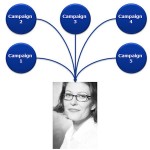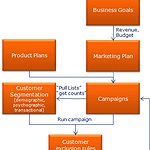Interactive marketing is a relatively new feature on the marketing and customer management landscape. It is only with the relatively recent advances in software tools that this dramatically more effective way to market to prospects and customers has come within the reach of most organisations.
And be assured that interactive marketing (also called trigger or event based marketing) can drive dramatic results: conversion rates of 45%, 35% reductions in direct marketing costs are just the tip of the iceberg.
However, to be successful there are seven critical success factors that you need to consider.
The Interactive Marketing success factors:
- Have The Right Technology
- Match the Channel to The Trigger
- Inbound Channels – Pre-think the Action
- Speed and Timing are Critical
- Measure Results
- Create a Dedicated Team
- Focus First on the Big Wins
1. Have The Right Technology
To implement trigger based marketing successfully you will require a base level of technology:
- The ability to monitor customer behaviour via a customer database of some type
- The ability to decide what to do; this needs a real time, rules based decisioning engine
- The ability to execute in a timely fashion
- Campaign management software
- Email marketing automation software
- Ability to input to face to face / contact centre channel
- The ability to report on what happened
These really are the basic requirements. With the advent of cloud based services like HubSpot, and Infusionsoft it doesn’t have to cost a fortune but you do need it.
2. Match the Channel to The Trigger
For instance if you are using analytics based triggers that rely on machine learning then you should use an automated channel; email or direct mail.
If you try to use a person based channel your staff will have problems believing in the trigger. That lack of belief will impact on their ability to deliver the treatment with conviction.
On the other hand if you have a rules based trigger that can be explained to staff then they can be very passionate in delivery.
3. Inbound Channels – Pre-think the Action
If you are using your inbound contact centre to deliver then the explanation you provide to staff needs to be “action based” .
You are not being fair to your inbound staff if you give them the trigger information but not how to react to the trigger. This is because they do not have the time to review the customer record and devise a response to the trigger while on the call.
Here’s a classic banking example:
When a customer has makes a large deposit in their transaction account it’s likely they will be considering how to invest that money to it’s a great trigger.
However, but provide the simple transaction fact to staff.
Instead pre-think the action you want them to take. In this example you could include a note in the customer’s record that the agent should:
Update client on new term deposit rates.
4. Speed and Timing are Critical
The effective lifetime of an event based marketing trigger can often be measure in hours if not minutes so you must automate the marketing process and drive down cycle time.
For example: When triggering an abandoned shopping cart email, you need to think about how long the person stays in the market for your product. If you delay your treatment (email or outbound call) too long, the purchase may have already been made from your competitor.
5. Measure Results
Proving results to the executive team to garner support and budget
This was the biggest challenge faced by marketers in a recent Forrester report. It just as important to measure success in interactive marketing as it is for all the rest of your marketing.
Unfortunately interactive marketing makes the measurement process harder. This is because campaigns no longer have clearly defined launch, response and report events. Instead a campaign may run for years with 50 executions a day. Over a year that mounts up to almost 20,000 interactions and associated costs.
It’s no coincidence that the second biggest challenges for marketers in that same Forrester research was:
Staffing marketing programs sufficiently.
If you don’t prove the value of interactive marketing process they are not likely to continue to fund the program.
6. Create a Dedicated Team
To improve your chances of success you should set up a dedicated team within your organisation to have end to end oversight of the process.
From idea generation through to trigger implementation, a single team can bring focus to your efforts.
This is not to say that the team is solely responsible for success, all of the relevant functions in the organisation should be supporting the work of the trigger team and have relevant B2B marketing KPIs to match.
7. Focus First on the Big Wins
While there may be lots of trigger campaigns that you can implement, you should focus first on those that offer the biggest bang. This ensures that management sit up and take notice of the work that is being done and support it with additional resources, as required.
You may even extend this approach to selecting opportunities that have a better big picture win if smaller ROI.
For instance choose projects that provide by revenue or gross margin gains over smaller volume but higher net ROI projects.
In terms of getting noticed, putting a big chunk of revenue on the bottom line will almost have more impact than a smaller revenue but higher net ROI project.
I've created an Excel Customer Lifetime Value Calculator: Download HereFirst published: 2 August 2011. Last Updated: 3 November 2020.





